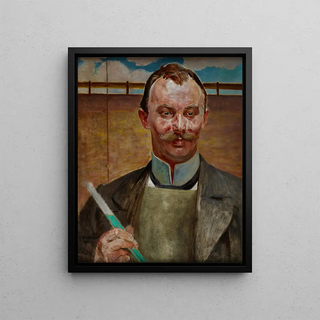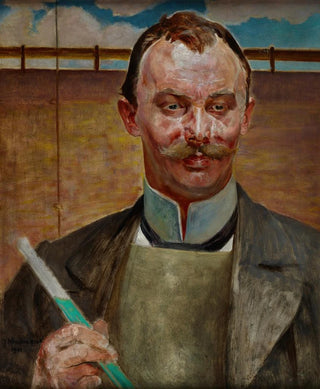Art print | Portrait of Alfred Stepek - Jacek Malczewski


View from behind

Frame (optional)
Portrait of Alfred Stepek - Jacek Malczewski – Captivating Introduction
In the vibrant landscape of Polish art at the end of the 19th century, the portrait of Alfred Stepek by Jacek Malczewski stands as a poignant testament to the cultural and artistic identity of its time. This artwork, imbued with symbolism and psychological depth, invites the viewer to delve into the inner universe of its subject. Alfred Stepek, an emblematic figure of Polish society, is here captured in a posture that evokes both reflection and melancholy. The art print of this portrait allows for a rediscovery not only of Malczewski's talent but also of the very essence of an era when painting echoed social and political upheavals.
Style and uniqueness of the work
Jacek Malczewski's style is characterized by a unique fusion of realism and symbolism, which is vividly expressed in the portrait of Alfred Stepek. The artist skillfully plays with light and shadow, creating an atmosphere that is both intimate and mysterious. The colors, both vibrant and nuanced, convey the complex emotions of the model, while the meticulous details of the face and clothing testify to undeniable technical mastery. Each brushstroke seems charged with meaning, revealing not only Stepek's personality but also the tensions and aspirations of a nation seeking its identity. This portrait is not merely a representation of an individual but a reflection on the Polish soul, an exploration of themes of memory, time, and cultural heritage.
The artist and his influence
Jacek Malczewski, born in 1854, is often regarded as one of the pioneers of symbolism in Poland. His artistic training, enriched by travels abroad, allowed him to incorporate diverse influences while remaining deeply rooted in his homeland. Malczewski was able to translate the concerns of his era through a work rich in meanings. His commitment to national themes and questions of identity is evident in his portraits, which become vectors of collective memory. The artist also played a crucial role in shaping the Polish art scene, inspiring

Matte finish

View from behind

Frame (optional)
Portrait of Alfred Stepek - Jacek Malczewski – Captivating Introduction
In the vibrant landscape of Polish art at the end of the 19th century, the portrait of Alfred Stepek by Jacek Malczewski stands as a poignant testament to the cultural and artistic identity of its time. This artwork, imbued with symbolism and psychological depth, invites the viewer to delve into the inner universe of its subject. Alfred Stepek, an emblematic figure of Polish society, is here captured in a posture that evokes both reflection and melancholy. The art print of this portrait allows for a rediscovery not only of Malczewski's talent but also of the very essence of an era when painting echoed social and political upheavals.
Style and uniqueness of the work
Jacek Malczewski's style is characterized by a unique fusion of realism and symbolism, which is vividly expressed in the portrait of Alfred Stepek. The artist skillfully plays with light and shadow, creating an atmosphere that is both intimate and mysterious. The colors, both vibrant and nuanced, convey the complex emotions of the model, while the meticulous details of the face and clothing testify to undeniable technical mastery. Each brushstroke seems charged with meaning, revealing not only Stepek's personality but also the tensions and aspirations of a nation seeking its identity. This portrait is not merely a representation of an individual but a reflection on the Polish soul, an exploration of themes of memory, time, and cultural heritage.
The artist and his influence
Jacek Malczewski, born in 1854, is often regarded as one of the pioneers of symbolism in Poland. His artistic training, enriched by travels abroad, allowed him to incorporate diverse influences while remaining deeply rooted in his homeland. Malczewski was able to translate the concerns of his era through a work rich in meanings. His commitment to national themes and questions of identity is evident in his portraits, which become vectors of collective memory. The artist also played a crucial role in shaping the Polish art scene, inspiring






